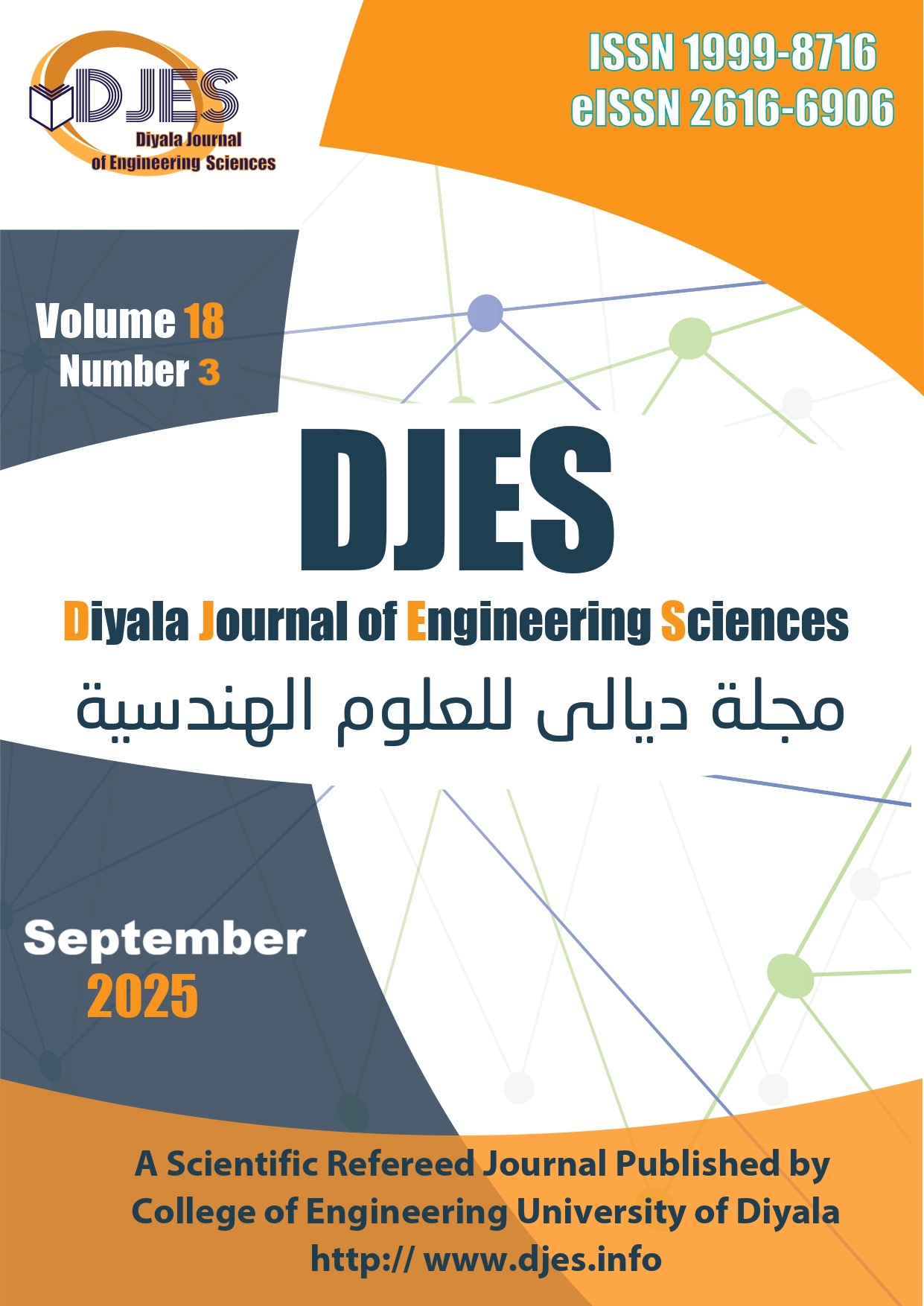Prediction of Daily Temperature Patterns in Iraq Using Deep Learning Models
DOI:
https://doi.org/10.24237/djes.2025.18315Keywords:
Climate Change, Temperature Forecasting, Time-Series Analysis, Long Short-Term Memory, Machine learningAbstract
The current study highlights the importance of accurate temperature prediction in Iraq, a country facing economic challenges due to its hot, arid climate and increasing climate change effects. Conventional forecasting methods, such as statistical and shallow machine learning models, struggle to address the complex time-dependent characteristics of meteorological data. The present study proposes to improve the temperature forecasting of the three large cities in Iraq, i.e., Dohuk, Erbil, and Mosul, using the deep learning models that can learn both short- and seasonal weather trends. A meteorological dataset of 24 years (2000-2024) was created with five major characteristics, namely, temperature, wind speed, relative humidity, total precipitation, and surface pressure. The models to be used in the deep learning model were three, namely (Long Short-term memory (LSTM), Gated Recurrent Unit (GRU), and Artificial Neural Network (ANN). The metrics of performance were Root Mean Squared Error (RMSE), Mean Absolute Error (MAE), Mean Squared Error (MSE), and R². The LSTM model performed the best in all the cities with RMSE values of 2.544, 2.366, and 2.323 and R² scores of 0.941, 0.948, and 0.952 in Dohuk, Erbil, and Mosul, respectively. The study confirms that LSTM is the most effective in modeling complex temporal dependencies in climatic time series, making it a significant contribution to understanding deep learning's application in weather forecasting in the Middle East. It suggests integrating AI-driven technology into the national meteorological system for climate-resistant decision-making in agricultural, water resource management, and urban development sectors.
Downloads
References
[1] J. P. Evans, “21st century climate change in the Middle East,” Clim Change, vol. 92, no. 3–4, pp. 417–432, Feb. 2009, doi: 10.1007/s10584-008-9438-5.
[2] W. H. Hassan, B. K. Nile, and B. A. Al-Masody, “Climate change effect on storm drainage networks by storm water management model,” Environmental Engineering Research, vol. 22, no. 4, pp. 393–400, Jun. 2017, doi: 10.4491/eer.2017.036.
[3] H. Chen, J. Guo, Z. Zhang, and C.-Y. Xu, “Prediction of temperature and precipitation in Sudan and South Sudan by using LARS-WG in future,” Theor Appl Climatol, vol. 113, no. 3–4, pp. 363–375, Aug. 2013, doi: 10.1007/s00704-012-0793-9.
[4] R.K. Pachauri and L.A. Meyer, “Climate Change 2014: Synthesis Report. Contribution of Working Groups I, II and III to the Fifth Assessment Report of the Intergovernmental Panel on Climate Change,” Geneva, Switzerland, 2014.
[5] M. H. Mohammed, H. M. Zwain, and W. H. Hassan, “Modeling the impacts of climate change and flooding on sanitary sewage system using SWMM simulation: A case study,” Results in Engineering, vol. 12, p. 100307, Dec. 2021, doi: 10.1016/j.rineng.2021.100307.
[6] R. J. Norby and Y. Luo, “Evaluating ecosystem responses to rising atmospheric CO 2 and global warming in a multi‐factor world,” New Phytologist, vol. 162, no. 2, pp. 281–293, May 2004, doi: 10.1111/j.1469-8137.2004.01047.x.
[7] A. Al-Saegh, “Identifying a Suitable Signal Processing Technique for MI EEG Data,” Tikrit Journal of Engineering Sciences, vol. 30, no. 3, pp. 140–147, Oct. 2023, doi: 10.25130/tjes.30.3.14.
[8] A. Al-Saegh, A. Daood, and M. H. Ismail, “Dual Optimization of Deep CNN for Motor Imagery EEG Tasks Classification,” Diyala Journal of Engineering Sciences, pp. 75–91, Dec. 2024, doi: 10.24237/djes.2024.17405.
[9] Kolaib, R. J., & Waleed, J. (2024). Crime Activity Detection in Surveillance Videos Based on Developed Deep Learning Approach. Diyala Journal of Engineering Sciences, 98-114.
[10] Flayyih, H. Q., Waleed, J., & Ibrahim, A. M. (2025). Indoor Air Quality Prediction in Sick Building Using Machine and Deep Learning: Comparative Analysis. Diyala Journal of Engineering Sciences, 203-218.
[11] K. A. Mohsen, B. K. Nile, and W. H. Hassan, “Experimental work on improving the efficiency of storm networks using a new galley design filter bucket.,” IOP Conf Ser Mater Sci Eng, vol. 671, no. 1, p. 012094, Jan. 2020, doi: 10.1088/1757-899X/671/1/012094.
[12] W. H. Hassan, B. K. Nile, K. Mahdi, J. Wesseling, and C. Ritsema, “A Feasibility Assessment of Potential Artificial Recharge for Increasing Agricultural Areas in the Kerbala Desert in Iraq Using Numerical Groundwater Modeling,” Water (Basel), vol. 13, no. 22, p. 3167, Nov. 2021, doi: 10.3390/w13223167.
[13] Th. O. Han, W. Z. Win and C. Th. K. Cho, “Assessment of Future Climate Change Projections Using Multiple Global Climate Models,” Civil Engineering Journal, Vol. 5, No. 10, pp. 2152-2166, Oct. 2019. http://dx.doi.org/10.28991/cej-2019-03091401
[14] J. M. Eden and M. Widmann, “Downscaling of GCM-Simulated Precipitation Using Model Output Statistics,” J Clim, vol. 27, no. 1, pp. 312–324, Jan. 2014, doi: 10.1175/JCLI-D-13-00063.1.
[15] E. Vanuytrecht, D. Raes, P. Willems, and M. A. Semenov, “Comparing climate change impacts on cereals based on CMIP3 and EU-ENSEMBLES climate scenarios,” Agric For Meteorol, vol. 195–196, pp. 12–23, Sep. 2014, doi: 10.1016/j.agrformet.2014.04.017.
[16] W. Hassan, “Climate change projections of maximum temperatures for southwest Iraq using statistical downscaling,” Clim Res, vol. 83, pp. 187–200, May 2021, doi: 10.3354/cr01647.
[17] R. L. Wilby et al., “A review of climate risk information for adaptation and development planning,” International Journal of Climatology, vol. 29, no. 9, pp. 1193–1215, Jul. 2009, doi: 10.1002/joc.1839.
[18] W. H. Hassan and R. M. Khalaf, “Optimum Groundwater use Management Models by Genetic Algorithms in Karbala Desert, Iraq,” IOP Conf Ser Mater Sci Eng, vol. 928, no. 2, p. 022141, Nov. 2020, doi: 10.1088/1757-899X/928/2/022141.
[19] M. N. :Khaliq, “An inventory of methods for estimating climate change-informed design water levels for floodplain mapping,” 2019.
[20] M. H. Mohammed, H. M. Zwain, and W. H. Hassan, “Modeling the quality of sewage during the leaking of stormwater surface runoff to the sanitary sewer system using SWMM: a case study,” Journal of Water Supply: Research and Technology-Aqua, vol. 71, no. 1, pp. 86–99, Jan. 2022, doi: 10.2166/aqua.2021.227.
[21] H. K. Jalal and W. H. Hassan, “Three-dimensional numerical simulation of local scour around circular bridge pier using Flow-3D software,” IOP Conf Ser Mater Sci Eng, vol. 745, p. 012150, Mar. 2020, doi: 10.1088/1757-899X/745/1/012150.
[22] Z. Xu, Y. Han, and Z. Yang, “Dynamical downscaling of regional climate: A review of methods and limitations,” Sci China Earth Sci, vol. 62, no. 2, pp. 365–375, Feb. 2019, doi: 10.1007/s11430-018-9261-5.
[23] H.-I. Eum, A. Gupta, and Y. Dibike, “Effects of univariate and multivariate statistical downscaling methods on climatic and hydrologic indicators for Alberta, Canada,” J Hydrol (Amst), vol. 588, p. 125065, Sep. 2020, doi: 10.1016/j.jhydrol.2020.125065.
[24] C.-Y. Lee, S. J. Camargo, A. H. Sobel, and M. K. Tippett, “Statistical–Dynamical Downscaling Projections of Tropical Cyclone Activity in a Warming Climate: Two Diverging Genesis Scenarios,” J Clim, vol. 33, no. 11, pp. 4815–4834, Jun. 2020, doi: 10.1175/JCLI-D-19-0452.1.
[25] W. H. Hassan, Z. H. Attea, and S. S. Mohammed, “Optimum layout design of sewer networks by hybrid genetic algorithm,” Journal of Applied Water Engineering and Research, vol. 8, no. 2, pp. 108–124, Apr. 2020, doi: 10.1080/23249676.2020.1761897.
[26] S. A. Adachi and H. Tomita, “Methodology of the Constraint Condition in Dynamical Downscaling for Regional Climate Evaluation: A Review,” Journal of Geophysical Research: Atmospheres, vol. 125, no. 11, Jun. 2020, doi: 10.1029/2019JD032166.
[27] W. H. Hassan et al., “Effect of Artificial (Pond) Recharge on the Salinity and Groundwater Level in Al-Dibdibba Aquifer in Iraq Using Treated Wastewater,” Water (Basel), vol. 15, no. 4, p. 695, Feb. 2023, doi: 10.3390/w15040695.
[28] A. M. Rasheed, “Adaptation of Water Sensitive Urban Design to Climate Change,” Queensland University of Technology, 2018. doi: 10.5204/thesis.eprints.122960.
[29] W. H. Hassan, H. H. Hussein, M. H. Alshammari, H. K. Jalal, and S. E. Rasheed, “Evaluation of gene expression programming and artificial neural networks in PyTorch for the prediction of local scour depth around a bridge pier,” Results in Engineering, vol. 13, p. 100353, Mar. 2022, doi: 10.1016/j.rineng.2022.100353.
[30] M. Z. Hashmi, A. Y. Shamseldin, and B. W. Melville, “Comparison of SDSM and LARS-WG for simulation and downscaling of extreme precipitation events in a watershed,” Stochastic Environmental Research and Risk Assessment, vol. 25, no. 4, pp. 475–484, May 2011, doi: 10.1007/s00477-010-0416-x.
[31] M. A. Semenov and E. M. Barrow, “LARS-WG A Stochastic Weather Generator for Use in Climate Impact Studies,” 2002.
[32] R. L. Wilby and C. W. Dawson, “Using SDSM Version 3.1-A decision support tool for the assessment of regional climate change impacts User Manual Sponsors of SDSM A Consortium for the Application of Climate Impact Assessments (ACACIA) Canadian Climate Impacts Scenarios (CCIS) Project Environment Agency of England and Wales,” 2004.
[33] S. L. Zubaidi, P. Kot, K. Hashim, R. Alkhaddar, M. Abdellatif, and Y. R. Muhsin, “Using LARS –WG model for prediction of temperature in Columbia City, USA,” IOP Conf Ser Mater Sci Eng, vol. 584, no. 1, p. 012026, Aug. 2019, doi: 10.1088/1757-899X/584/1/012026.
[34] M. Costa-Cabral et al., “Climate variability and change in mountain environments: some implications for water resources and water quality in the Sierra Nevada (USA),” Clim Change, vol. 116, no. 1, pp. 1–14, Jan. 2013, doi: 10.1007/s10584-012-0630-2.
[35] H. Birara, R. P. Pandey, and S. K. Mishra, “Projections of future rainfall and temperature using statistical downscaling techniques in Tana Basin, Ethiopia,” Sustain Water Resour Manag, vol. 6, no. 5, p. 77, Oct. 2020, doi: 10.1007/s40899-020-00436-1.
[36] I. Hassan, R. M. Kalin, C. J. White, and J. A. Aladejana, “Selection of CMIP5 GCM Ensemble for the Projection of Spatio-Temporal Changes in Precipitation and Temperature over the Niger Delta, Nigeria,” Water (Basel), vol. 12, no. 2, p. 385, Feb. 2020, doi: 10.3390/w12020385.
[37] C. B. Chisanga, E. Phiri, and V. R. N. Chinene, “Reliability of Rain-Fed Maize Yield Simulation Using LARS-WG Derived CMIP5 Climate Data at Mount Makulu, Zambia,” Journal of Agricultural Science, vol. 12, no. 11, p. 275, Oct. 2020, doi: 10.5539/jas.v12n11p275.
[38] W. T. Hailesilassie, N. K. Goel, T. Ayenew, and S. Tekleab, “Future precipitation changes in the Central Ethiopian Main Rift under CMIP5 GCMs,” Journal of Water and Climate Change, vol. 13, no. 4, pp. 1830–1841, Apr. 2022, doi: 10.2166/wcc.2022.440.
[39] N. Saddique, C. Bernhofer, R. Kronenberg, and M. Usman, “Downscaling of CMIP5 Models Output by Using Statistical Models in a Data Scarce Mountain Environment (Mangla Dam Watershed), Northern Pakistan,” Asia Pac J Atmos Sci, vol. 55, no. 4, pp. 719–735, Nov. 2019, doi: 10.1007/s13143-019-00111-2.
[40] S. Punyawansiri and B. Kwanyuen, “Forecasting the Future Temperature Using a Downscaling Method by LARS-WG Stochastic Weather Generator at the Local Site of Phitsanulok Province, Thailand,” Atmospheric and Climate Sciences, vol. 10, no. 04, pp. 538–552, 2020, doi: 10.4236/acs.2020.104028.
[41] H. Algretawee, R. J. M. Al-Saadi, M. F. Al Juboury, W. H. Hasan, B. K. Nile, and M. A. Kadhim, “Determination of Difference Amount in Reference Evapotranspiration between Urban and Suburban Quarters in Karbala City,” Journal of Ecological Engineering, vol. 23, no. 7, pp. 180–191, Jul. 2022, doi: 10.12911/22998993/149720.
[42] X. Fan, L. Jiang, and J. Gou, “Statistical downscaling and projection of future temperatures across the Loess Plateau, China,” Weather Clim Extrem, vol. 32, p. 100328, Jun. 2021, doi: 10.1016/j.wace.2021.100328.
[43] S. Doulabian, S. Golian, A. S. Toosi, and C. Murphy, “Evaluating the effects of climate change on precipitation and temperature for Iran using RCP scenarios,” Journal of Water and Climate Change, vol. 12, no. 1, pp. 166–184, Feb. 2021, doi: 10.2166/wcc.2020.114.
[44] Z. Karevan and J. A. K. Suykens, “Transductive LSTM for time-series prediction: An application to weather forecasting,” Neural Networks, vol. 125, pp. 1–9, May 2020, doi: 10.1016/j.neunet.2019.12.030.
[45] Q. Guo, Z. He, Z. Wang, S. Qiao, J. Zhu, and J. Chen, “A Performance Comparison Study on Climate Prediction in Weifang City Using Different Deep Learning Models,” Water (Basel), vol. 16, no. 19, p. 2870, Oct. 2024, doi: 10.3390/w16192870.
[46] J. K. Mutinda, A. K. Langat, and S. M. Mwalili, “Forecasting Temperature Time Series Data Using Combined Statistical and Deep Learning Methods: A Case Study of Nairobi County Daily Temperature,” Int J Math Math Sci, vol. 2025, no. 1, Jan. 2025, doi: 10.1155/ijmm/4795841.
[47] G. Camps-Valls et al., “Artificial intelligence for modeling and understanding extreme weather and climate events,” Nat Commun, vol. 16, no. 1, p. 1919, Feb. 2025, doi: 10.1038/s41467-025-56573-8.
[48] M. Bonavita, “On Some Limitations of Current Machine Learning Weather Prediction Models,” Geophys Res Lett, vol. 51, no. 12, Jun. 2024, doi: 10.1029/2023GL107377.
[49] A. E. Abdelkareem, “Performance Analysis of Deep Learning based Signal Constellation Identification Algorithms for Underwater Acoustic Communications,” Diyala Journal of Engineering Sciences, pp. 1–14, Sep. 2024, doi: 10.24237/djes.2024.17301.
[50] R. Yang et al., “Interpretable machine learning for weather and climate prediction: A review,” Atmos Environ, vol. 338, p. 120797, Dec. 2024, doi: 10.1016/j.atmosenv.2024.120797.
Downloads
Published
Issue
Section
License
Copyright (c) 2025 Mustafa S Mustafa, Basma A.M. Al-Jawadi

This work is licensed under a Creative Commons Attribution 4.0 International License.












